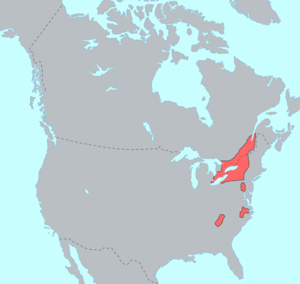Iroquoian languages
| Iroquois | |
|---|---|
| Geographic distribution: | eastern North America |
| Linguistic classification: | One of the world's primary language families |
| Proto-language: | Proto-Iroquoian language |
| Subdivisions: | |
| ISO 639-2 / 5: | iro |
| Glottolog: | iroq1247[1] |
|
Pre-European contact distribution of the Iroquoian languages. | |
The Iroquoian languages are a First Nation and Native American language family in North America. They are known for their general lack of labial consonants. Iroquoian languages are polysynthetic and head-marking.[2]
Today, all surviving Iroquoian languages except Cherokee and Mohawk are severely endangered, with only a few elderly speakers remaining.[3]
Family division
- Southern Iroquoian
- Northern Iroquoian
- Lakes Iroquoian
- Five Nations and Susquehannock
- Huronian
- Tuscarora–Nottoway
- Lakes Iroquoian
- Unclear
- Laurentian (†)
Scholars are finding that what has been called the Laurentian language appears to be more than one dialect or language.
In 1649 the tribes constituting the Huron and Petun confederations were displaced by war parties from Five Nations villages (Mithun 1985). Many of the survivors gathered, ultimately forming the Wyandot tribe. Ethnographic and linguistic field work with the Wyandot (Barbeau 1960) yielded enough documentation for scholars to characterize and classify the Huron and Petun languages.
The languages of the tribes that constituted the Wenrohronon, Neutral and the Erie confederations were very poorly documented. These groups were called Atiwandaronk, meaning 'they who understand the language' by the Huron. They are historically grouped with them.
The group known as the Meherrin were neighbors to the Tuscarora and the Nottoway (Binford 1967) in the American South and may have spoken an Iroquoian language. There is not enough data to determine this with certainty.
External relations
Attempts to link the Iroquoian, Siouan, and Caddoan languages in a Macro-Siouan family are suggestive but remain unproven (Mithun 1999:305).
Iroquois linguistics and language revitalization
As of 2012, a program in Iroquois linguistics at Syracuse University, the Certificate in Iroquois Linguistics for Language Learners, is designed for students and language teachers working in language revitalization.[4][5]
Six Nations Polytechnic in Ohsweken, Ontario offers Ogwehoweh language Diploma and Degree Programs in Mohawk or Cayuga.[6]
See also
Notes
- ↑ Nordhoff, Sebastian; Hammarström, Harald; Forkel, Robert; Haspelmath, Martin, eds. (2013). "Iroquoian". Glottolog. Leipzig: Max Planck Institute for Evolutionary Anthropology.
- ↑ Mithun, Marianne. "Grammaticalization and Polysynthesis: Iroquoian" (PDF). Retrieved June 8, 2015.
- ↑ "Iroquoian Languages". www.languagegeek.com. Retrieved 2015-08-09.
- ↑ "Certificate in Iroquois Linguistics for Language Learners". University College. Retrieved 2012-09-06.
- ↑ Gale Courey Toensing (2012-09-02). "Iroquois Linguistics Certificate at Syracuse University Comes at Important Time for Native Languages". Indian Country Today Media Network. Retrieved 2012-09-06.
- ↑ Six Nations Polytechnic
Bibliography
- Barbeau, C. Marius (1960), Huron-Wyandot Traditional Narratives in Translations and Native Texts, National Museum of Canada Bulletin 47; Anthropological Series 165, [Ottawa]: Canada Dept. of Northern Affairs and National Resources, OCLC 1990439.
- Binford, Lewis R. (1967), "An Ethnohistory of the Nottoway, Meherrin and Weanock Indians of Southeastern Virginia", Ethnohistory (Ethnohistory, Vol. 14, No. 3/4) 14 (3/4), pp. 103–218, doi:10.2307/480737, JSTOR 480737.
- Chilton, Elizabeth (2004), "Social Complexity in New England: AD 1000–1600", in Pauketat, Timothy R.; Loren, Diana Dipaolo, North American Archaeology, Malden, MA: Blackwell Press, pp. 138–60, OCLC 55085697.
- Goddard, Ives, ed. (1996), Handbook of North American Indians, Vol. 17: Languages, Washington, DC: Smithsonian Institution, ISBN 0-16-048774-9, OCLC 43957746.
- Lounsbury, Floyd G. (1978), "Iroquoian Languages", in Trigger, Bruce G., Handbook of North American Indians, Vol. 15: Northeast, Washington, DC: Smithsonian Institution, pp. 334–43 [unified volume Bibliography, pp. 807–90], OCLC 58762737.
- Mithun, Marianne (1984), "The Proto-Iroquoians: Cultural Reconstruction from Lexical Materials", in Foster, Michael K.; Campisi, Jack; Mithun, Marianne, Extending the Rafters: Interdisciplinary Approaches to Iroquoian Studies, Albany: State University of New York Press, pp. 259–82, ISBN 0-87395-781-4, OCLC 9646457.
- Mithun, Marianne (1985), "Untangling the Huron and the Iroquois", International Journal of American Linguistics 51 (4), pp. 504–7, doi:10.1086/465950, JSTOR 1265321.
- Mithun, Marianne (1999), The Languages of Native North America, Cambridge: Cambridge University Press, ISBN 0-521-23228-7, OCLC 40467402.
- Rudes, Blair A. (1993), "Iroquoian Vowels", Anthropological Linguistics 37 (1), pp. 16–69.
Further reading
- Driver, Harold E. 1969. Indians of North America. 2nd edition. University of Chicago Press. ISBN 9780226164670
- Ruttenber, Edward Manning. 1992 [1872]. History of the Indian tribes of Hudson's River. Hope Farm Press.
- Snow, Dean R. 1994. The Iroquois. Blackwell Publishers. Peoples of America. ISBN 9781557862259
- Snow, Dean R.; Gehring, Charles T; Starna, William A. 1996. In Mohawk country: early narratives about a native people. Syracuse University Press. An anthology of primary sources from 1634-1810.
| ||||||||||
| ||||||||||||||||||||||

